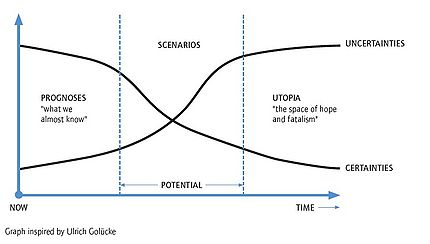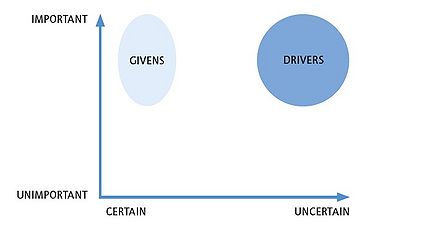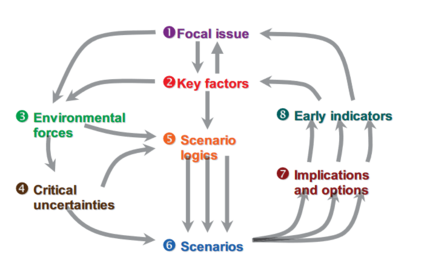Scenario Planning
Developed by Karoline Bråten
Abstract
For a construction company to achieve success is it important to have good planning within the business. Most planes are based on predictions of the future, however the future is unknown, complex and changes much faster than in previous times. By developing and using scenario planning, will the company be prepared for the possible range of futures.
Scenarios are alternative futures in which today's decisions may play out. [1] Scenario planning are complex elements intertwined into a story that is coherent, systematic comprehensive and plausible. The scenarios should not only include visionary stories, but stories that also challenge the organization.[2] Scenario planning are used to help the company to reach the right decisions in the event of different scenarios.
Scenario planning in businesses and thus construction management are divided into two categories. The first category is used to foresee a future state or condition, which is further used to simulate the choices and actions that may be taken to deal the scenario and the related consequences. The second category assumes that the choices has been established and the consequences are integrated into the story about the future state of the business. The first category simulates the thinking-process, and the second the exploring of the consequences of the choices taken. [3] Further in this article will scenarios be referenced to as a combination of these two categories.
Scenario planning was developed in the 1950’s by Herman Kahn, [4] and even though the tool is hard to establish when to be used, is “uncertainty” a common denominator. When choosing to applying scenario planning is it common to follow some common characteristics and elements divided into phases. The number of scenarios is varying, however there is a danger in developing three scenarios. The common perception is to choose the middle-scenario, the “average”.
Scenario planning has become a popular tool for businesses. Even though we do not know how the future will look like, we do know that it will not look like the past or today, however, you can be involved in how it will unfold. As a company globalizes will it, sometime in the future, be in the position where it must deal with costumers, regulators, culture, economic factors, etc. [3] Moreover, whichever scenario that become reality, will the business be more prepared with scenario planning.
Purpose
The primary purpose of scenario planning is to enable the construction manager to detect and explore, as many as possible, alternative futures to clarify the present actions and related consequences. The scenarios will inform and influence the manager. Fahey and Randall 1998 suggest that the purpose of scenario planning is to help seeing the potential future, how it might come about and why is it happening, and thus enlarging the understanding. [5] It will additionally explore how the organization might react if curtain circumstances occur, and thus identify the liable decisions. [6]
History
Scenario planning as a device for future planning was developed by Herman Kahn in the 1950’s. Khan was a central part of raising awareness of the US military, which is often referred to as the development of the nuclear war. In the 1970’s had the Royal Dutch Shell remarkable success after applying scenario planning, the company adjusted quickly after the OPEC oil shock in the 1970’s. [4] Shell is to this day, 10.06.17, still using scenario planning to help leaders explore ways forward and make better decisions.[7] It was also during the 1970’s that the consulting firm SRI International formulated a structural approach to scenario planning. [6] Moreover, it was with the report “The Limits of Growth to the Club of Rome” that scenario approach first entered the public’s awareness in 1972.[8]
Application
When to Use the Tool
Traditional planning tends to plan for an ideal future and listing the actions that should be taken to achieve this goal. However, the future is unknown and unexpected changes occur which moves the ideal future out of reach. [9]
It is hard to say when a construction manager should use scenario planning, however there are some conditions that would be in favor of applying it according to Paul J. H. Schoemaker’s “When and How to Use Scenario Planning: A Heuristic Approach with Illustration: [10]
- The uncertainty is high related to the company’s ability to predict or adjust
- The company has experienced too many unexpected costly surprises in the past
- The strategic planning has become too routinized and therefor the quality of strategic thinking is low
- The industry is experiencing changes or is about to
- There are strong differences of opinions and each have its qualities
- Etc.
How to Use the Tool
In scenario planning are multiple scenarios often used to categorize the range of how the future might evolve.
There have been attempts on shortcuts with only planning the best- and the worst-case scenarios with the actions related to these scenarios. However, the future is not black and white and the limited scenarios are most likely not sufficient. A future-thinking construction manager must plan for several scenarios based on the probable future situations that have been predicted from actual trends. Scenario planning requires however allot of resources and research. [9] Because of the demanding time and resource might not scenario planning be applicable for small construction firms.
The scenarios should deal with a matter that are important for the construction company, at the same time shall the matter be associated with uncertainty – is it possible to give an answer of the development of the subject in the upcoming years. Moreover, should the company have a certain potential impact on the future. [8] Further elaboration on the process of creating scenarios follows.
Phases
During the years after the introduction in the 1950’s has there been several processes of constructing a scenario. However, there are some common characteristics and elements that can be discerned. The scenario should be focused on the needs of some issue, decision, strategy or plan. It should be logically structured and consistent. The process should be highly adaptable and capable of the given situation. In the final product should there be a high degree of ownership for the construction company. [6] The methodology differs from sources to sources, however there are some basic elements and processes throughout the stages of scenario planning. The following steps are commonly used:[8]
- Approaching the questions and the timeline of the scenarios
- Identifying and ranking the uncertainties and givens
- Produce the initial scenarios
- Reduce the scenarios and choose the most plausible
- Draft the remaining scenarios
- Reflect on the outcomes of the scenario
Phase 1 - Questions and Time-frame
Often are the general frame of reference given by the title of the project. An example from the author “There will be more extreme climates because of the climate-changes, how will the construction industry adapt to these changes”. The group should be at least 20-30 individuals who are effected by the issue of the project. Given the example should there be participants with knowledge of climate changes, construction engineers, geologists, etc. - the participants should bring a broad range of perspective on the issue at hand. At the first workshop should the participants as the questions of “What is the project about?”, “How will we be affected?”, etc.
All the scenarios should have the same time-frame, however it might be challenging to set a specific start and end. The frame should be as far from the present so it has room for change, but not as far into the future that it drifts into utopia and thereby loos all its relevance connection with the present. However, it should not be spent allot of time or energy to decide the time-frame. It is the characteristics of the development of the scenario that are important, not the exact moment of their realization. [8]
Phase 2 - Identifying and Ranking the Uncertainties and Givens

In principle is there unlimited number of possible futures, however in reality are the number reduced – the future can only develop on the past. Thus, to narrow the number of futures are the history of the topics researched. To avoid overconfidence is it wise to discuss the topics carefully, including the pros and cons.
Phase 3 - Produce the Initial Scenarios
The number of starting scenarios varies, however the scenarios developed should reflect the consequences and the direction of the development of the issue. These questions should be reflected again and again so the scenario does not lose itself in the land of abstract considerations. Another important reflection in this phase are to consider how the developments can be dealt with and/or how people will react to it. When developing the scenarios is it important to keep in mind the time-frame of the scenarios. [8]
Phase 4 - Reduce the Scenarios and Choose the Most Plausible

In this phase are you eliminating the scenarios that are irrelevant or questionable. The remaining number of scenarios is varying and dependent on the resources of the company. However, between two and four is mentioned as sufficient to explore the plausible future. [11]
Phase 5 - Draft the Remaining Scenarios
Scenarios are stories about a plausible future. The aim of this phase is to develop the scenarios, remembering that they should bring you from status quo to the end-state. It is also important to keep in mind the managers how are going to implement the actions. It might be wise for the construction manager to participate in this process.
Phase 6 - Reflect on the Outcomes of the Scenarios
In this phase should you also reflect on if the scenario is plausible, as in phase 4. It might be wise to reflect on the previous phases to achieve more knowledge. A good scenario is, according to Meinert and Schoemaker: [8][10]
- Novel – the scenarios reflects on an extension of the future and furthermore include elements of surprise.
- Multifaceted – The present in not black or white, therefore shouldn’t the scenarios reflect this either. All the scenarios developed should be equally complex, likely and ambiguous.
- Believable – Scenarios should be surprising and unexpected, and at the same time consistent and logical.
- Comprehensive – Scenarios should combine trends and developments on several levels and on various issues. They seek beyond trends and extrapolations in order to understand the deeper force driving the system.
- Never right or wrong – As definition is a scenario an analysis of what which have not happened, we are speculating and guessing, hence there is no single correct scenario. The scenarios are only potential futures, expressed in logical and consistent manners.
However, a good scenario is highly subjective and is always in the eye of the beholder.
Limitations
Anticipation and scenarios are not synonymous. A scenario is not an end in itself, the scenario only becomes meaningful when its results and implications are embodied in real action.
Scenario planning are time and resource consuming process, the process might take over a year in a large construction company. Like in every process that develops over time, are there a risk for knowledge to be lost by changes of the team members and/or leaders/managers. A future study rarely survives if the initiator leaves the project. [11]
The use of scenarios has been met with mixed results, John S. Ratcliffe in “Scenario Building: A suitable Method for Strategic Construction Industry Planning?” [6], have written some recommendations regarding scenario planning.
- Scenario planning are team exercises and it is important that the team members are representative of the organization. There should be a balance between staff personnel, which are confined to supporting the line managers in shaping the scope and focus of the scenario.
- The expectations of the scenario must be realistic. An appropriate time frame should be set, both for the scenarios and the time it takes to build them. It often takes time for the organization that the future will not resemble the past, and it might be hard to look far enough into the future.
- There is a danger in ending up with an odd-number of scenarios, and then especially three. In the case of lack of experience with scenario planning is it often assumed that there is two “extremes” and one “average” when dealing with three scenarios, there are tendencies to go towards the middle and choose the “average”. There is also an underlying danger to assume that there is a “right” answer when dealing with scenario planning. However, the true value of scenario planning is to experience the exploring of a set of plausible futures that could unfold.
- It is important that the scenario planning is not isolated, it should be resolutely being linked to the existing planning, management and budgeting process of the organization.
Annotated bibliography
When and How to Use Scenario Planning: A Heuristic Approach with Illustration,In Journal of Forecasting, Paul J. H. Schoemaker, 1991 The paper offers a step-by-step analysis of scenario planning, with description of what scenario planning aim to achieve. Schoemaker gives examples of situations when applying scenario planning is appropriate. The paper also gives an example of a case involving a manufacturing company to view the process.
Scenario building, European Trade Union Institute, Sascha Meinert, 2014 The manual gives a comprehensive description of what scenario planning is and how the company applying the tool should use it. The manual gives several examples within the text to achieve a deeper understanding. Meinert describes and go through the phases of scenario planning thoroughly, with illustrations for a deeper explanation. The manual also gives an example of the time schedule of a scenario project in the appendix.
The Art of Scenario and Strategic Planning: Tools and Pitfalls, Michel Godet, 2000 The paper gives a good description of scenario planning and how to develop scenarios. Godet describe the phases, with additional illustrations on how the scenarios as developed and how they iterate. There are several examples of how scenario planning has been used. Godet also provides an integrated schema of strategic prospective.
Scenario Building: A Suitable Method for Strategic Construction Industry Planning?, John S. Ratcliffe, 2009 The paper is mainly about the scenario method. Ratcliffe go through how to build the scenario and how planning can be used to identify and test scenarios for strategic decision-making in the construction industry. The practice, principles and pitfalls of scenario planning is also explored in the paper. Ratcliffe use scenario planning to identify some of the drivers that Ireland is confronted with.
Scenario Planning, Joseph F. Coates, 2000 The paper goes through the introduction of scenario planning in the 1950’s, and why scenario planning has a great value. Coates goes through how to create scenarios thoroughly, in addition to have several examples throughout the text. Coates go through shells great success by using scenario planning, as they are the best known creators of scenarios according to the paper.
References
- ↑ 1.0 1.1 Noboru, Konno, Ikujiro, Nonaka, Jay, Ogilvy, "Scenario Planning: the Basics", 2014, http://www.tandfonline.com.proxy.findit.dtu.dk/doi/abs/10.1080/02604027.2014.875720
- ↑ Ringland, Gill, Young, Laurie, "Scenario in Marketing: From Vision to Decision", 2006, http://onlinelibrary.wiley.com.proxy.findit.dtu.dk/doi/10.1002/9780470666265.ch1/summary;jsessionid=E879888381F2AABB2519BF365DAD1086.f03t02
- ↑ 3.0 3.1 Coats, Joseph F., "Scenario Planning", page 115-123, 2000, http://production.datastore.cvt.dk/filestore?oid=53a033d1ecd9f0954c085a67&targetid=53a033d1ecd9f0954c085a69
- ↑ 4.0 4.1 Schumacher, "Constructing Vision with Scenario Planning", 2012 Proceedings of PICMET '12: Technology Management for Emerging Technologies, page 122-132, 2012, http://ieeexplore.ieee.org.proxy.findit.dtu.dk/document/6304030/
- ↑ Fahey, L., Randall, R.M., "Learning from the Future - Competitive Foresight Scenarios", New York: John Wiley & Sons, Inc., 1998, http://documents.irevues.inist.fr/handle/2042/30148
- ↑ 6.0 6.1 6.2 6.3 Ratcliffe, John, S., "Scenario Building: A Suitable Method for Strategic Construction Industy Planning?", Chicago, 2009, http://www.emeraldinsight.com.proxy.findit.dtu.dk/doi/full/10.1108/02637470010328322
- ↑ Shell Scenarios [Online], Available: http://www.shell.com/energy-and-innovation/the-energy-future/scenarios.html , [Accessed 10 June 2017]
- ↑ 8.0 8.1 8.2 8.3 8.4 8.5 8.6 8.7 8.8 8.9 Sascha, Meinert, "Scenario Building", European Trade Union Institute, 2014, http://www.etui.org/Publications2/Guides/Field-manual-Scenario-building
- ↑ 9.0 9.1 Isaacs, S. J., Construction Business owner, "How to Use Scenario Planning for Yours Construction Company", August 2011, Available: http://www.constructionbusinessowner.com/topics/strategy/construction-company-management/how-use-scenario-planning-your-construction-company/page/0/1, [Accessed 11 June 2017]
- ↑ 10.0 10.1 10.2 Schoemaker, Paul J. H, "When and How to use Scenario Planning: A Heuiristic Approach with Illustrations", In Journal of Forecasting, Chicago, page 549-564, 1991
- ↑ 11.0 11.1 Michel Godet, "The Art of Scenario and Strategic Planning: Tools and Pitfalls", New York, 2000, http://production.datastore.cvt.dk/filestore?oid=53a033ceecd9f0954c085a4f&targetid=53a033ceecd9f0954c085a51